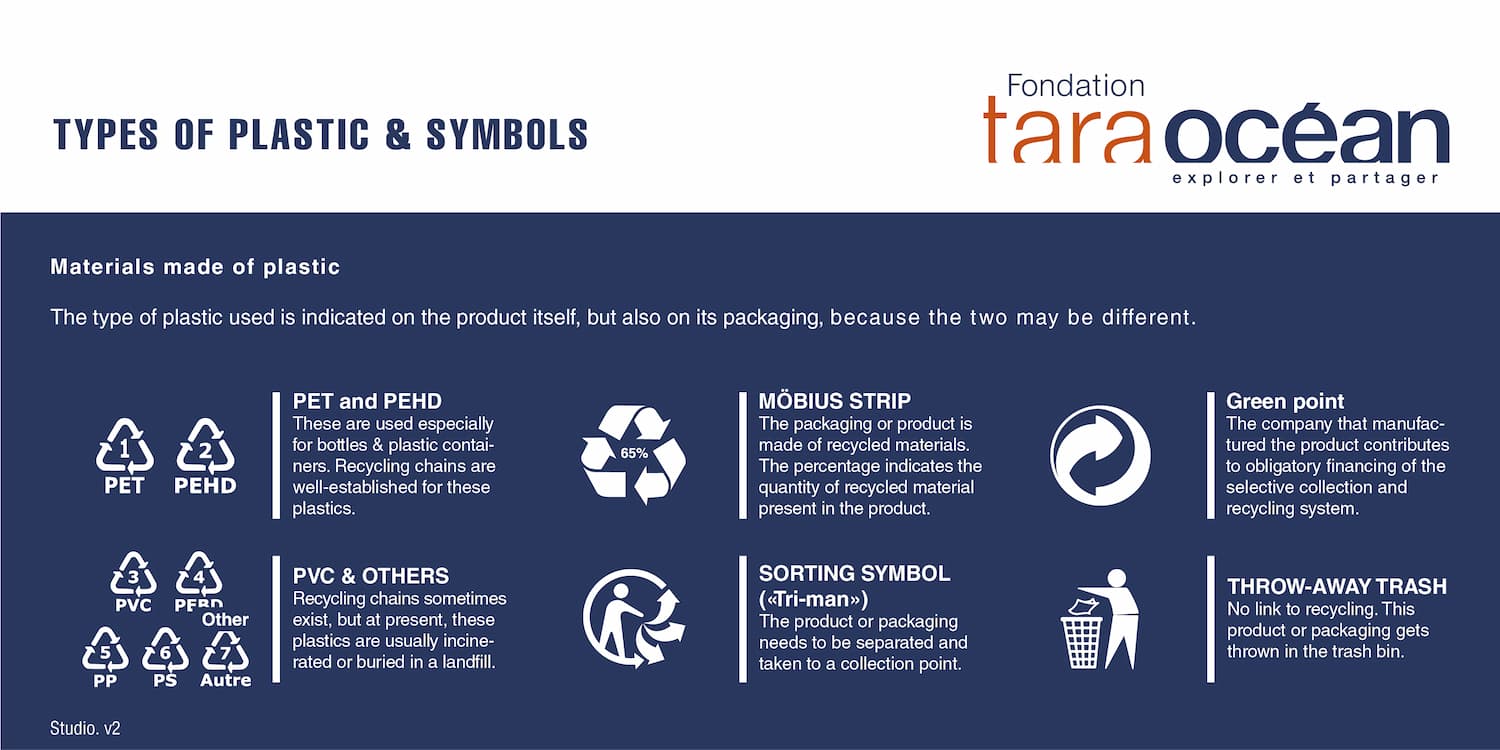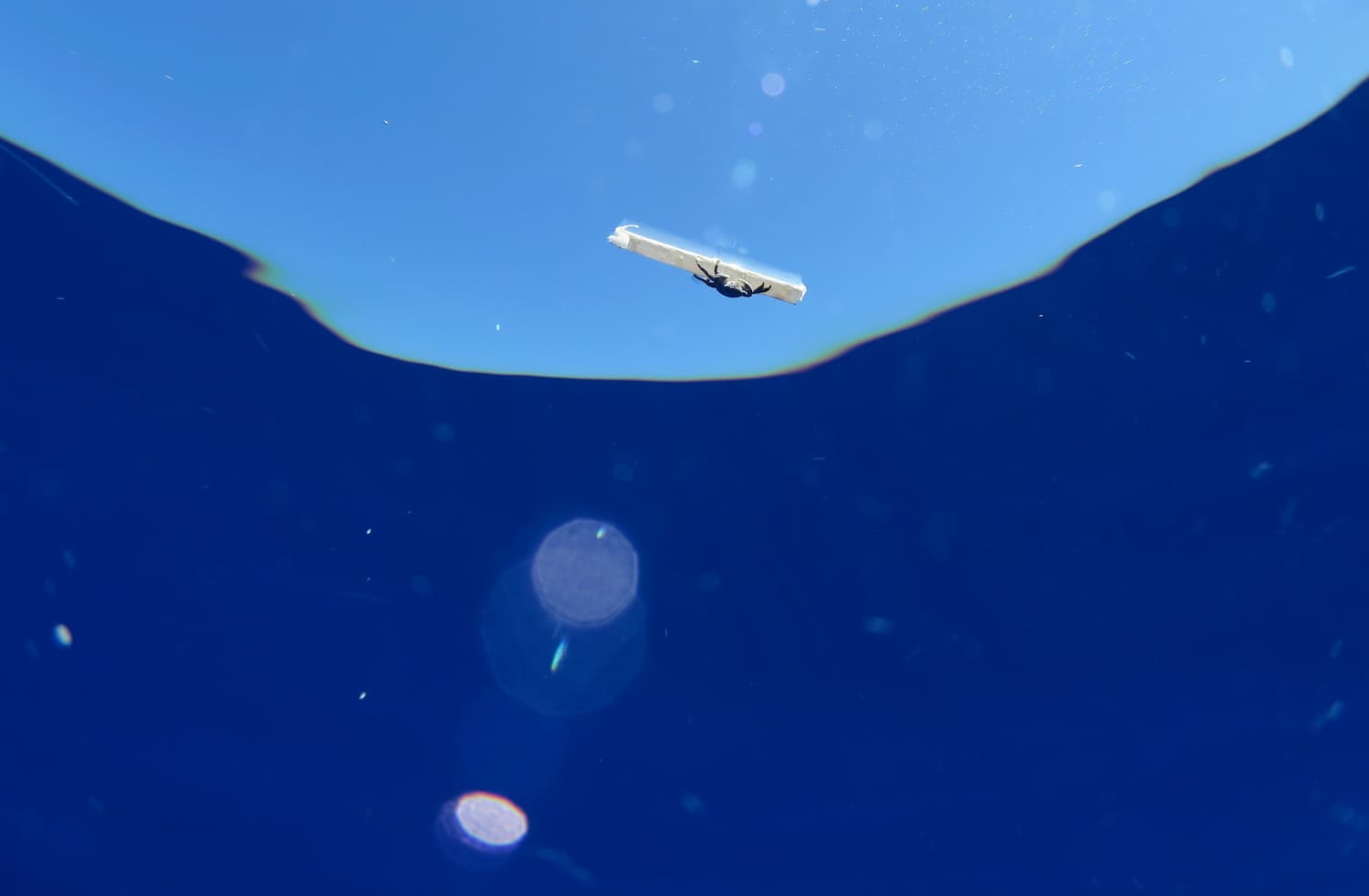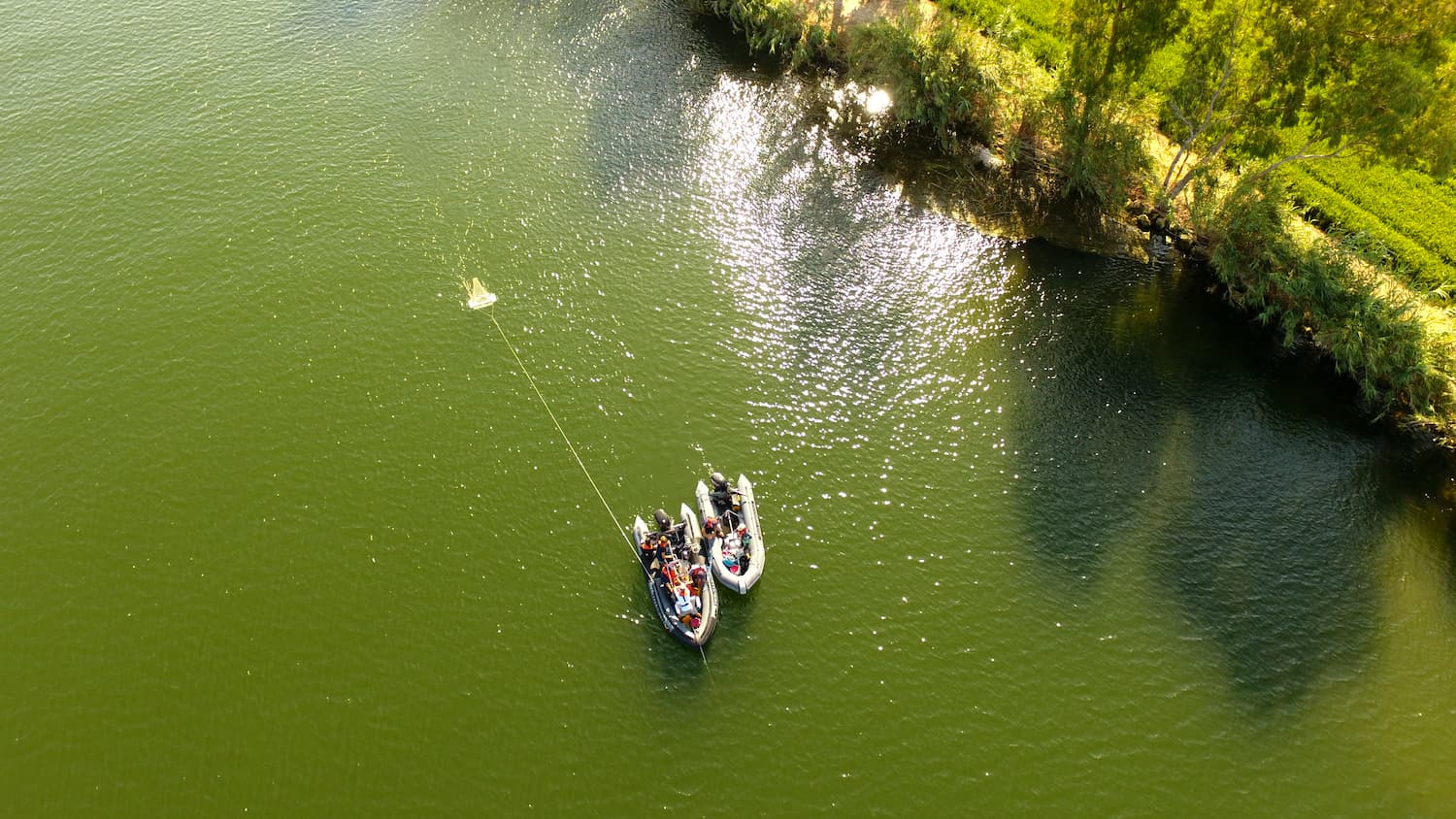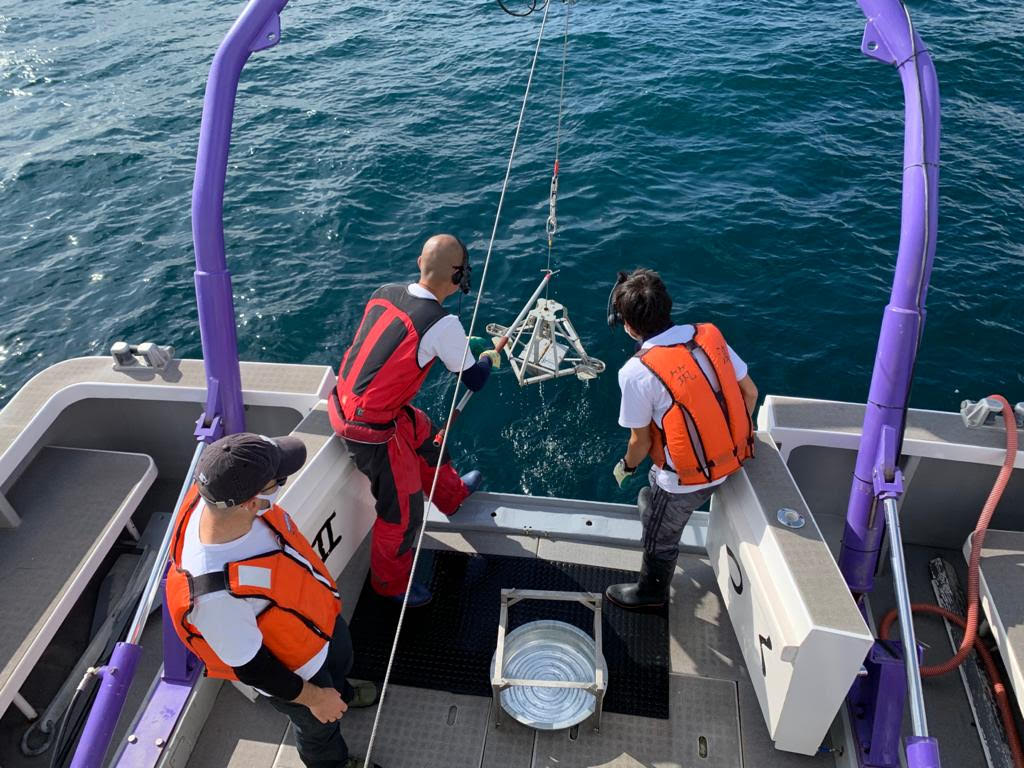Plastic pollution in the Ocean: What are the Tara Ocean Foundation’s levers for action?
From the poles to the Equator, samples collected aboard Tara during her expeditions all have one thing in common: the presence of plastic! Everywhere marine biodiversity now coexists with plastic particles invisible to the naked eye, getting confused with the planktonic organisms that we are studying. This issue is now at the heart of all the Tara Ocean Foundation’s missions. Citizens, politicians and industrialists — everyone must be mobilized to collectively reach solutions that measure up to the challenge.
What is plastic?
Plastic is not a single material. There are thousands of types, with a wide variety of visual, mechanical and technical properties. This diversity of physical properties can be explained in two ways: First by the initial diversity of plastic polymers such as polypropylene (PP), polystyrene (PS), polyvinyl chloride (PVC) or polyethylene (PET). Second, by the hundreds of chemical additives added to these polymers to give them their final technical properties — transparency, flexibility, impermeability, etc. The combination of these polymers and additives ultimately results in an almost infinite variety of plastics.

What are the advantages of plastic?
The majority of the initial polymers used for producing plastic today come from the transformation of oil. Production costs are particularly low. This favorable price, combined with their wide diversity of properties, allowed plastics to massively supplant glass, wood, and even textile fibers for most uses. In addition, this domination of plastic on the market is accentuated by a consumer system pushing for single use and cost reduction.
What are the problems caused by plastics?
Cette diversité infinie de plastiques et les difficultés de collectes sélectives rendent la grande majorité des plastiques impossibles à recycler aujourd’hui et même dans les vingt années à venir. En France, 73,6 % des plastiques sont enfouis en décharges ou incinérés émettant ainsi des polluants encore mal compris vers l’air, l’eau et les sols. Même les plastiques les plus recyclables, comme le polyéthylène (PET), ne sont que très peu recyclés : actuellement, à peine plus de la moitié des bouteilles d’eau PET est recyclée.
The flow of plastic to the Ocean doesn’t come only from the leakage of uncollected waste. When exposed to weather conditions such as rain, wind, hail, or to direct sunlight, plastic objects release microplastic particles through wear. This wear — minimal on the scale of a single object or installation — ultimately represents a gigantic flow considering all the plastic installations in place today. For example: rainstorms create runoff water loaded with microplastics from synthetic sports fields and playgrounds; rubber particles from tires left on roads by moving vehicles; car paint; and even corrugated polycarbonate roofs. Runoff water carries the microplastics into the soil, and into the rivers and streams that end their course in the Ocean.
Why is plastic pollution a problem for the Ocean?
Not all plastics have the same impact on marine ecosystems. There are as many levels of toxicity as there are plastics. Nevertheless, ALL of them are harmful.
The most visible impacts are caused by macroplastics that fish, turtles, birds and marine mammals can ingest or become trapped in. But this pollution only represents a tiny part of the plastic flow that arrives in the Ocean. The vast majority come in the form of microplastics, measuring between 5 millimeters and a few hundred nanometers, and those even smaller than one micrometer, named nanoplastics. This invisible flux exposes marine ecosystems to new toxicity which we are continuing to discover, because plastics in the microscopic state have very different impacts. Some plastics that had been deemed unproblematic in the macroscopic state are now the subject of studies revealing dramatic effects when considered in the microplastic state. This is the case, for example, of polystyrene.
Visible pollution starting at the base of the food chain
The effects of plastics are observable at all levels of marine ecosystems. The presence of certain microplastics in the water causes stress on the micro-algae constituting the first level of the food chain. Faced with this stress, the micro-algae consume the energy reserves they had stored for maintaining their cellular functioning. By consuming these reserves, they deplete their nutritive benefit for the zooplankton and the fish that consume them. Ingesting the same quantity of microalgae, predators receive a much lower energy supply. The presence of microplastics in the water threatens the structure of the entire ecosystem, and ultimately the fish resources on which billions of people on Earth depend.
An increase in the phenomenon of bio-accumulation of microplastics
Microplastics enter food chains at their very foundations, and then pass from one organism to another. Organisms are not able to eliminate the plastics they ingest, so we observe a phenomenon of concentration of microplastics in their tissues. This is called « bioaccumulation ». Once inside the body, the plastic’s impacts are multiple, depending on the monomer, the additives, the size of the plastic particle, and of the contaminated organism. Ingested microplastics can cause reduced fertility, impaired growth, endocrine-disrupting effects, and even carcinogenicity.
Plastics are a problem due to their intrinsic toxicity, but also because they act as « pollutant sponges », fixing certain compounds such as pesticides. When they penetrate organisms, they bring along all the molecules they have fixed.
Plastic waste facilitates the migration of organisms
Plastics drift with the currents. Some living organisms take advantage of this to get a free ride. By attaching themselves to these microscopic rafts, they can cover much greater distances than they would by themselves, and can have an invasive character in the regions they reach. These species then threaten the balance of ecosystems that have been in place for thousands of years.

Above all, the main problem with plastics is the huge quantity that ends up in the Ocean. Every single minute the equivalent of a garbage truck full of plastic waste flows into the Ocean. The lifespan of these plastics can be hundreds of years. We are therefore witnessing a phenomenon of perpetual increase in the concentrations of plastic particles. Even the least problematic plastics accumulate, and their effects on ecosystems are notable.
How does Tara study microplastic pollution?
Tara’s research on plastic pollution began in 2014 during the Tara Mediterranean mission. Scientific teams were interested in the interactions between plastic particles and plankton. The Mediterranean Sea is one of the most polluted in the world because its closed geography makes it an important basin of accumulation. This is reflected in our first observations: of the 2,000 samples collected, ALL contained plastic fragments. These samples allowed us to characterize the plastics found, as well as to quantify the concentrations present in the water. In some places, concentrations of surface microplastics were even identical to those of zooplankton. In these regions, the food eaten by fish is 50% plastics!
Our investigations continued in 2019 with a mission entirely dedicated to the study of plastic pollution: the Microplastic Mission. In partnership with 19 research laboratories, the schooner voyaged along the 4 European seaboards, and sailed up 9 of Europe’s major rivers. The objectives of this mission were multiple:
- identify sources of pollution
- understand the fragmentation of microplastics in rivers
- predict their dispersion towards the Ocean
- understand their impacts on marine biodiversity and their effects on the food chain
Once again, not a single sample was spared from plastics. But the first lesson of this mission concerns the fragmentation of plastics into microplastics: this process happens much further upstream in the rivers than was previously thought!

Our focus on the interaction between sources of pollution on land and the Ocean is continuing during the current mission, the Microbiomes Mission, during which the Amazon and 4 African rivers are the subject of similar protocols. The resulting data will improve our knowledge of the impact of plastic pollution on the marine microbiome.
Finally, increasing our knowledge is also accomplished through the participatory science operation Plastic through the Magnifying Glass which offers middle school and high school students the opportunity to contribute to the inventory of plastic pollution on the beaches and shores of France. By applying a protocol provided by researchers who’ve been collaborating with the Tara Ocean Foundation for several years on the study of microplastics, students produce a database of samples and results that can be used for the publication of scientific articles. As with the samples taken during the schooner’s missions, this database is public and accessible to all.
What does the Foundation do to act against plastic pollution?
Understanding the effects of plastic pollution on marine ecosystems is a necessary prerequisite for taking action. The Foundation communicates this need for action to all stakeholders in this plastic issue: citizens, political decision-makers and industrialists.
Raising public awareness
The Foundation shares scientific knowledge during the schooner’s stopovers and everywhere in France throughout the year. To this end, Tara’s Ocean Culture teams have developed various awareness-raising tools for people of all ages.
- exhibition: Plastic at sea: the solutions are on land
- teaching kit on the same theme
- documentaries
These supports are deployed during numerous events related to the Ocean, and in various structures sharing scientific culture.

Mobilize politicians and industrialists
The main levers of action to combat the plastic scourge are in the hands of politicians and industrialists. The Foundation is actively working on educational material to convert the scientific knowledge produced aboard the schooner into information useable in everyday life.
Creating a dialogue between scientists and decision-makers — whether political or industrial — is what we call « advocacy ». For the problem of plastic pollution, this work is first carried out at a local level with the mayors of French municipalities.
- The Charter «River without Plastic»: mobilizing local elected officials
Following the Microplastics Mission and our first observations showing that plastics decompose into microplastics as soon as they pass through river waters, the Tara Ocean Foundation, alongside the Compagnie Nationale du Rhône (CNR) and Initiatives for the Future of Great Rivers (IAGF) proposed that the mayors of France sign a «River without Plastic» Charter — committing their cities to implementing concrete actions to reduce plastic pollution. The Foundation and our partners are actively working to support and equip these signatory communities. A guide of good practices to fight against plastic pollution was presented to the mayors in November 2021. This guide explains the actions that are legally possible to implement, taking into account the municipalities’ capacities.
- The Plastic Packaging Pact: informing manufacturers
In addition to this Charter, the Tara Ocean Foundation proposed a «Plastic Packaging Pact» to manufacturers. A working group initiated by the government encourages reflection on reducing the use of plastics that are most problematic because they are toxic or non-recyclable. The Foundation’s expertise provides manufacturers with scientific knowledge from the field, complementary to their own knowledge of the realities of the plastics industry, their specific production and their recycling possibilities. The prospect of total elimination of plastics in our society is illusory, in the short and medium term. Our support work for industrialists is therefore necessary to collectively target a rapid exit from the most problematic plastics.
- Proposed amendment: helping to advance public debate
The Tara Ocean Foundation is also attentive to the opportunities that the political calendar can offer. This was the case with the Climate Bill for which the Foundation submitted an amendment aimed at banning polystyrene from packaging by 2025. Although this amendment was not retained in the version of the law finally adopted, we were able to write and submit it thanks to solid scientific knowledge derived from the Tara missions. This knowledge makes it possible to prioritize issues by taking into account the impacts of plastics on biodiversity, their abundance in the natural environment, and the fields of use of the plastic concerned.
Polystyrene — the third most prevalent plastic in our samples — is over-represented in the natural environment, relative to the quantity produced. Polystyrene’s physical properties facilitate its slow degradation in the Ocean, causing an extremely wide range of impacts on the ecosystem.
- Towards International Plastic Advocacy
Plastic is a global problem. Tara’s missions — on all the seas of the globe — have clearly demonstrated this. It’s therefore on an international scale that plastic advocacy must be organized. The last few weeks have sent a first positive signal: the United Nations Environment Program (UNEP) adopted, during the fifth session of the United Nations Environment Assembly in Nairobi, a resolution for an international treaty on plastic pollution. This resolution kicks off long and complex negotiations, but the desire for a legally binding agreement, inclusion of a scientific committee, integration of various parts of civil society, and presence of regular reporting on effective application — form the basis of an ambitious Treaty. The Tara Ocean Foundation will work in this direction so that this resolution materializes into a final text that lives up to the hopes generated.

Tara-Jambio mission: study of microplastic pollution in Japan
Study of microplastic pollution in Japan